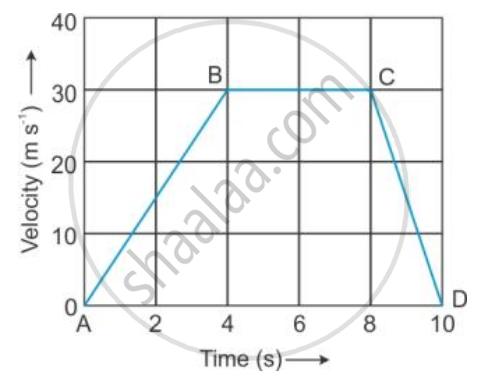Advertisements
Advertisements
प्रश्न
The distance between Delhi and Agra is 200 km. A train travels the first 100 km at a speed of 50 km/h. How fast must the train travel the next 100 km, so as to average 70 km/h for the whole journey ?
उत्तर
We have the following data to find the speed for the second part of the journey:
Total distance to be travelled by train (D) = 200 km
Average speed required (vavg) = 70 km/hr
Time required for the entire journey (T) :
`"Time" = "Total Distance"/"Average speed"`
= `200/70` hr
T = `20/7` hr
For the first part of the trip:
Distance covered (d1) = 100 km
Speed for this part of journey (v1) = 50 km/hr
Time taken for the first part of journey :
`"Time" = "Distance travelled"/"Speed"`
So,
t1 = `100/50` hr
= 2 hr
For the second part of the trip,
Distance covered (d2) = 100 km
Time taken for the second part of journey :
t2 = T-t1
= `(20/7 - 2)` hr
= `6/7` hr
Speed of the train for the second part of the journey :
= `"distance travelled"/"Time"`
= `((100)(7))/6`
= 116.67 km/hr
APPEARS IN
संबंधित प्रश्न
Name the physical quantity which gives us an idea of how slow or fast a body is moving.
Fill in the following blank with suitable word:
The physical quantity which gives both, the speed and direction of motion of a body is called its……………
A train travels the first 15 km at a uniform speed of 30 km/h; the next 75 km at a uniform speed of 50 km/h; and the last 10 km at a uniform speed of 20 km/h. Calculate the average speed for the entire train journey.
When is a body said to be in motion?
Figure shows the displacement of a body at different times .

Calculate the average velocity during the time interval 5 s to 9 s ,
[Hint : From 5 s to 9 s , displacement = 7 m - 3m = 4m]
From the displacement-time graph of a cyclist given below in the Figure, find The average velocity in the first 4 s.

The velocity-time graph of a moving body is given below in Figure

Total displacement.
What is the relation between distance and time when the body is moving with uniform velocity?
A body projected vertically up with a velocity of 10 m/s reaches a height of 20 m. If it is projected with a velocity of 20 m/s, then the maximum height reached by the body is:
What are the uses of equations of motion?
